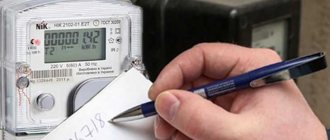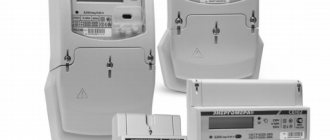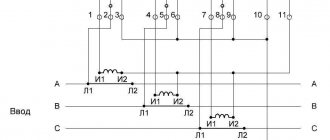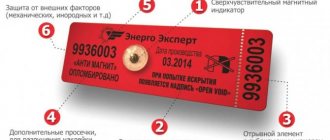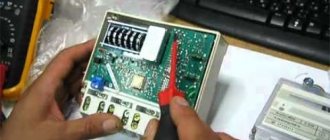According to accepted world practice, electricity consumers must install devices that take into account its consumption and pay according to their readings. In the Russian Federation, this requirement is enshrined at the legislative level. Taking readings and calculating payment based on them is the responsibility of the consumer (owner of the device). But if, as a rule, there were no problems with induction electricity meters, then with the advent of electronic devices, many consumers have questions about taking readings. The answers to them can be found in this publication.
Induction meters
This process for old-style devices is quite simple; it is enough to rewrite the information from the mechanical indicator, where the numbers display the total amount of electricity consumption over the entire period of operation of the device. After this, the readings for the previous period are subtracted from the resulting number. The result is multiplied by the current tariff.
The information is included in the payment receipt. Once every six months, energy companies have the right to monitor the metering device, which obliges the consumer to provide access to it.
Induction meter readings with drum
In the figure above, the segments of the mechanical indicator that display an integer are marked in red, and tenths of kilowatt-hours are marked in blue. There are models without displaying the fractional part. The meter's rated current, voltage, and frequency parameters are shown below. By the rotation speed of the drum, you can visually assess the current load power.
Important! Tenths are not included in the receipt.
Induction devices are gradually being replaced by electronic ones due to their undoubted advantages. Let's tell you what they are.
Payment Methods
Today, the population is provided with several main options for paying for consumed electricity:
- Bank branches and self-service devices. You need to transfer money using a payment document or through a special section of the terminal.
- Personal account, payment services, mobile applications. To do this you will need access to the Internet.
- Post offices or payment centers.
- Directly to the utility service provider through branch cash desks.
Regardless of the chosen method, you must receive confirmation of the completed payment.
Advantages of new electronic metering devices
The first glance at the front panel of an electronic device can cause some confusion. Instead of the usual mechanical indicator, there is a digital display and some strange buttons.
Electronic meter front panel
In fact, there is nothing complicated; below we will describe in detail how to take readings from various electronic models. As for their advantages, these include:
- Indication of the current date and time.
- Saving readings for the previous month in the device memory.
- Transferring data with readings to the control center of the energy company providing the services.
- Possibilities of multi-mode tariffing.
- The current sensor can be a shunt, a current transformer, or both.
It makes sense to consider the last point in more detail.
Automatic data transfer
Recently, thanks to the widely developed information network, which operates quite quickly with huge volumes of data, as well as the ability to organize separate communication channels, electronic electricity consumption meters with automatic data transmission have appeared. The only problem is the complexity of installation and configuration, but subscribers do not have to participate in the process of collecting and transmitting data.
Taking CE303 meter readings using the iRZ MC52i-485GI GSM modem (video instructions)
What is multi-tariff mode and its purpose?
As you know, the load on the energy system is uneven. During the day, electricity consumption is several times higher than at night (to be precise, the peak occurs in the morning and evening). In order to motivate the population, multi-tariff systems have been introduced in many countries, including Russia, taking into account the characteristics of a particular city (settlement).
The most common is the two-tariff system (day-night), and its three-tariff modification (peak-half-peak-night) is also found. The transition to such metering schemes can significantly reduce electricity costs. As an example, we give the prices for various time zones for the city of St. Petersburg (for an apartment with a gas stove).
Example: tariff table for St. Petersburg.
| Tariff name | Cost, rub) | |
| Single | 4,32 | |
| Dual zone | day – T1 (7:00-23:00) | 4,55 |
| night – T2 (23:00-7:00) | 2,62 | |
| Three-zone | peak – T1 (7:00-10:00 and 17:00-21:00) | 4,58 |
| half peak - T2 (10:00-17:00 and 21:00-23:00) | 4,32 | |
| night – T3 (23:00-7:00) | 2,62 | |
As you can see, the difference in price between night and day rates is slightly less than twofold. Even if you only turn on the washing machine when the nightly tariff is in effect, you can save a lot.
To switch to a two or three tariff system, it is necessary to install an electronic electricity meter, the design of which allows for such a count. As for induction modifications, they do not have such functionality.
Checking the correct operation of the electric meter
The consumer may doubt that the meter correctly records energy consumption. The main reason for doubt is that the readings increase even when (as the consumer believes) all devices that consume electricity are turned off. But it should be noted that when turned off, household appliances usually operate in standby mode. A TV, microwave, computer, electric bell and other devices consume minimal amounts of energy, even if they are not currently turned on. To ensure that the meter is operating correctly, you need to disconnect absolutely all equipment from the power supply. If the meter stops, it means it is working properly.
How to take electricity meter readings day-night?
Due to the large assortment of electronic models, it is not possible to give a single algorithm of actions. Detailed instructions are given in the technical documentation that comes with each device. Later in the article we will describe in detail the process for the most common models, but for now we will talk about the general principle of calculations using a two-tariff system.
All electronic meters have a built-in clock, which allows you to record electricity consumption for different time zones. In two-tariff models there are two of them - T1 (day) and T2 (night), their validity periods were given in the table above. A separate count is kept for each period. At the same time, the device stores the readings of the previous reporting period in memory, which is quite convenient for calculations. The easiest way to explain the process is with an example.
Let’s say we need to take readings on October 20, for the current date they are as follows:
- For tariff T1 – 2052.95 kWh.
- T2 – 1024.16.
- Total – 3077.11.
We rewrite this data into a receipt and call up information for the previous reporting period (September 20), let’s say we display:
- T1 – 1892.81.
- T2 – 926.1.
- Total – 2818.91.
We calculate the difference and then write down the result:
- T1 – 160.14.
- T2 – 98.06.
- Total – 258.2.
We enter this information on the receipt. Next, we calculate the payment by multiplying by their cost in accordance with current tariffs. For example, according to the information in the table above, for St. Petersburg these calculations will be as follows:
T1 - 160.14 x 4.55 = 728.67 rubles.
T2 – 98.06 x 2.62 = 256.92 rubles.
Total – 728.67 + 256.92 = 985.59 rubles.
https://www.youtube.com/watch?v=pW1977Cfpds
How is energy measured?
Translated from Greek, energy means activity, force, action. It is a scalar quantity and measures all kinds of motion and interconnections of matter. Energy is denoted by the letter E. The units of measurement for this quantity are: in the SI system - joule (J), in the GHS system - erg.
Electrical energy consumed by electrical appliances is calculated by meters. They provide numerical readings of power consumption (kW) per kWh.
The Relationship Between Strength and Energy
A connection has been established between the conservative force, which causes the potential energy of all interacting bodies, and this energy.
For your information. Conservative forces are those forces that do work to move a point. In this case, the work is determined by the extreme positions of this point: initial and final.
Conservative forces include the following forces:
- heaviness;
- elasticity;
- Coulomb forces.
If you close the trajectory of a point under the action of conservative forces, it will be equal to zero.
You can trace the connection using the following algorithm:
- When at any point in space a body is subject to the action of a conservative force, it means that it is located in a potential field.
- A change in the position of a body within a field causes a change in potential energy, in which a conservative force does work.
This work can be expressed mathematically. For example, the body moved in a random direction r, deviating from the initial position by a very small distance dr. This means that dA = F*dr*cosα = Fr, dr, where F = F* cosα is the projection of the force onto the direction r.
There is an equality: dA = – dEп, where Ep is potential energy. So, putting an equal sign between the two expressions, it turns out:
Fr *dr = – dEп, from which Fr = – dEп/dr is expressed.
The ratio dEп/dr is a quantity showing the rate of change of potential energy along a given direction; it is the derivative of Ep in the r direction.
Attention! The minus sign means a decrease in potential energy in the direction dr. The partial derivative symbol indicates that the differentiation of the potential energy Ep (x, y, z) occurs only with the argument x, with the other two unchanged.
Power and energy
Power P is the work done per unit of time. The unit of power is watt (W). To find out how many watts are 1 kW, you need to remember that “kilo” is 103. Therefore, 1 kW = 103 W, and 10 kW = 104 W.
Typically, the power of electrical receivers is measured in kilowatts. Applicable to technology, there is also a measurement of power in horsepower (hp). One such horsepower is equal to 736 watts.
Power and horsepower
The ability of a certain body or an entire system to perform work is characterized by its energy. Energy unites in its concept all events in nature. Different types of movement are characterized by different types of energy.
Advice. Mechanical energy related to the movement of a body is called kinetic, associated with the mutual position of bodies (body parts) of the system - potential.
Calories and joules
Before you figure out how to convert (convert) calories to joules and vice versa, you need to know what these two concepts mean.
The joule is a unit used to measure work, energy, or heat. In the international SI system, the joule is denoted by J (J). The work done by a force of one newton (1N) to move a point in the direction of application of the force one meter (1m) is equal to one joule (1 J).
Calorie is a quantity not separately reflected in measurement systems, used to determine the amount of heat. To heat 1 g of water by 1 C0, you need to spend energy equal to 1 calorie (cal). In this case, 1 cal = 4.1868 J.
Communication with other units
You can use an online calculator to express calories in joules and back.
The program interface allows you to enter the values of the required quantities (using abbreviations of multiple values). When you don’t have the Internet at hand, it’s easy to make a translation by making a proportion. For example, you need to find out how many kilocalories are in 100 kJ. To do this, make up the proportion:
- 1 kcal = 4.1868 kJ;
- X = 100 kJ.
Solving the proportion, we get the expression X = 100 * 1/4.1868 = 23.9 kCal. The answer is that 100 kJ contains 23.9 kcal.
How to take readings from electricity meters Mercury 200, 206, 233, 230, 231, 234
The listed models have a similar interface. Control is carried out using two buttons (see Fig. 3). One, with the inscription “ENTER”, is used to select indications of various tariffs, the second, which shows a ring with an arrow pointer, is used to select a mode.
Front panel of three-phase meter Mercury 230
The procedure for taking readings is as follows:
- It is necessary to set the appropriate mode, in this case “A”. To switch modes, you need to briefly press the button with the ring until a dash appears under the corresponding letter on the display (marked in red in Fig. 3).
- After setting the “A” mode, the display will show the readings for the T1 tariff; to view the data for other tariffs (T2 and T3), you must briefly press the “ENTER” button. The number of tariffs is determined by the meter settings; they are made by employees of the energy company.
- Information is displayed in the following format:
- Tariff name (T1-T3).
- Actually, the readings (a number with two decimal places).
Please note that these devices have special software. Thanks to it, you can get more detailed information when connecting the meter to a PC.
Universal configurator for the Mercury line of meters
You may also like
Three-phase electricity meter “Pulsar 3/T3” RS485 without button
Designed for measuring and metering active or reactive electrical energy in single or multi-tariff mode. The meter can be used autonomously or as part of automated systems for monitoring and accounting of electricity (ASKUE).
Interverification interval - 16 years; Average service life - 32 years; Average time between failures - 318,160 hours; The service life of the meter from one lithium battery is at least 16 years.
from 6328₽
Buy in bulk
Electric meter “Pulsar 1T” LCD RS485 optoport without button
Designed to account for active and reactive energy in 2-wire AC power frequency circuits. The meter can be used autonomously or as part of automated systems for monitoring and accounting of electricity (ASKUE).
Produced in accordance with GOST 31818.11-2012, GOST 31819.21-2012, GOST 31819.23-2012
Number in the state register of measuring instruments of the Russian Federation: 76979-19
Interverification interval - 16 years; Average service life - 32 years; Average time between failures - 318,160 hours; The service life of the meter from one lithium battery is at least 16 years.
from 5482₽
Buy in bulk
Electric meter “Pulsar 1T” LCD LoRa optoport without button
Designed to account for active and reactive energy in 2-wire AC power frequency circuits. The meter can be used autonomously or as part of automated systems for monitoring and accounting of electricity (ASKUE).
Produced in accordance with GOST 31818.11-2012, GOST 31819.21-2012, GOST 31819.23-2012
Number in the state register of measuring instruments of the Russian Federation: 76979-19
Interverification interval - 16 years; Average service life - 32 years; Average time between failures - 318,160 hours; The service life of the meter from one lithium battery is at least 16 years.
from 2947₽
Buy in bulk
How to take readings from the electricity meter Energomer CE 101, CE 102, TsE6803V?
For electronic devices of Energomer models, the procedure for obtaining readings is quite simple and does not require any pressing of control keys; in fact, on some modifications they are absent altogether.
Front panel of meter CE 102
Every 10-15 seconds, the display cyclically displays the data of time zones from T1-T2 or T1-T3 (depending on the modification of the device) and their total value. In this case, the name of the tariff (T1-T3 and T - the total amount) and, in fact, the readings in the form of a number with two decimal places are displayed at the top of the screen.
Front panel of meter TsE6803V housing type P32 (for DIN rail)
It is not possible to view readings for the previous period.
From joule to kilowatt
Since 1 kW is one thousand watts, the relationship between these two system quantities is considered initially based on one watt.
Joule concept
How is power measured?
When applied to an electrical circuit, 1 J is equal to the work that electric field forces do in 1 second (s) to maintain a current of 1 ampere (A) at a voltage of 1 volt (V). In other words, 1 kJ = 1 kWh.
Converting joules to kilowatt hours
To convert a known number of joules into kilowatt-hours, this is done by direct and reverse conversion of mechanical and electrical energy. This is necessary when performing calculations of the performance of electrical machines: engines and generators.
Important! For calculations, the well-known relation 1 MJ = 0.277(7) kW⋅h is used, from which it follows that 1 kW⋅h = 3.6 MJ. Mega is 1*106.
For example, you need to convert 15 MJ to kWh . To do this, multiply 15 by 0.277:
15*0.277 = 4.15 kWh.
If it is necessary to determine how many joules are 15 kW h , calculate as follows:
15*3.6 = 54 MJ = 54000 kJ = 54*106 J.
The fairness of such calculations is based on the fact that the implementation of the transition to another measurement system was carried out taking into account time. One hour in minutes is equal to 60 minutes. A minute, in turn, consists of 60 seconds, and there are 3600 of them in one hour. One kilowatt contains 1000 watts. Multiplying the number of watts by the number of seconds gives the size of one joule - 3.6 million (MJ). Recording energy consumption in kilowatts for billing calculations has made it easier to evaluate meter readings.
Changing the dimension of power units
You can often come across questions related to the dimension of P units . The most common questions are:
- what is a kilowatt?
- how many kWh in kW;
- how much is 1kW equal to watt;
- 1 kW is how much watt or quat is it;
- how many watts are in 1 kW;
- what is the number of kilowatts per kilowatt hour?
Despite all the variations of letter abbreviations, everything is simple. A kilo is a thousand, so 1 kW is equal to 1000 watts (W). This is also true for volts - 1 kilovolt (kV) is equal to 1000 volts. One thousand kilowatts is equal to 1 megawatt (MW). The multiplicity of units helps to clearly determine the ranks of power values P.
Using these data, it is convenient to plan your family budget. By multiplying the power consumed by the device by the amount of time it is in use, you can estimate its daily consumption. Multiplying the daily load by the number of calendar days in a month allows you to accurately estimate the energy consumption of the entire home.
How to take readings from a Micron electricity meter?
This procedure is also not difficult. Using the button (marked in red in Fig. 7), the appropriate information display mode is selected.
Micron Counter
On the case, below the information board, the names of the modes are printed; a “bird” is depicted on the screen above the current one. To take readings correctly, you need to use the button to set the T1-T3 mode. For example, if the mark is above T2, then the displayed data will correspond to the indicators of the selected tariff.
We hope that the information provided will help those who do not know how to take meter readings.
Features of determining network power
In general, the electrical network is designed so that its operation does not require special knowledge. It is enough to follow some rules, the main one of which is to prevent overload.
You may be interested in Features of resonance in an electrical circuit
Important! Failure to comply with the rules for using the electrical network can lead to failure and even fire.
It is important to note that the technical characteristics of the outlet and the household appliance differ from each other:
- In sockets, the maximum permissible alternating current is measured in Amperes: in the old housing stock of Russia it is 6 A, in Europe - 10 or 16 A;
- The power of connected devices is measured in Watts.
Information on an electrical appliance can be marked in different ways.
How to calculate the power of electricity? To calculate, you will need a formula:
P = U*I, where:
P - power,
U - voltage in Volts,
I is the current strength in Amperes.
The voltage of a working outlet is 220-230 Volts; the current can be measured with a multimeter.
To determine the current in the outlet, you should use a multimeter.
How is power consumption measured?
The amount of current spent is measured in Watts (W) or Volt-Amperes (VA). Measurement in Volt-Amps is often found among foreign manufacturers, and in Watts - among Russian ones.
Important! Often they indicate not Watts (W) or Volt-Amps (VA), but kiloWatts (kW) and kiloVolt-Amperes (kVA) - a thousand Watts and a thousand Volt-Amps.
Many people believe that W and VA are equal quantities, but this is not so. Active power is measured in Watts (the amount of energy consumed, denoted by the letter “P”), in Volt-Amps - total power (the sum of active and passive powers, denoted by “S”). That is, these quantities are not equal; it is impossible to equate Watts to Volt-Amperes.
The required values can be indicated directly on the equipment
To translate you need to use the formula:
P = S*power factor.
If the coefficient is unknown, it is taken as 0.8 (0.8-0.95 is a good value, 0.65-0.8 is satisfactory).
You can also use online calculators when calculating. If using the formula does not work, you can approximately equate: 1 kVA = 0.7 kW.
Calculation example
For example, let’s take a conventional apartment equipped with an individual meter. The owner just took a reading: 56100 kW.
Last month it recorded 55830 kW.
To find out the amount of energy expended, he subtracts the smaller from the larger:
56100 – 55830 = 270 kW.
In his area the tariff is 3.5 rubles.
270 x 3.5 = 945 rub.
That's how much he has to pay for the month.
In conclusion, we would like to add that there are many ways to pay for electricity. You can fill out the received receipt, go to the nearest bank, or even do it without leaving your home, on the website of the relevant organization. Also, many banks provide services for paying for electricity via the Internet.
Many apartment owners do not agree to pay for heating according to average rates. A heat meter for an apartment will allow you to pay for the heat actually spent.
Instructions for making an electrolyzer with your own hands are presented in this topic.
